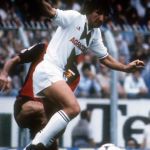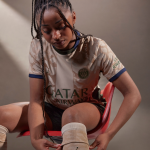
When Americanino sponsored Udinese
One of the many fashion brands that decided to enter football in the 1980s
February 11th, 2022
Before Italian football was invaded by the big sportswear brands, which quickly monopolised the world of sponsorship, Italian clubs used to rely on fashion brands for their shirts. A bit like Napoli, who entrusted EA7 with the task of designing their ten jerseys worn so far this season, Udinese relied on another historic clothing brand, Americanino, from 1981 to 1984. The brand was founded at the end of the seventies, and since its launch recorded a great success also due to the fact that Americanino jeans were an irreplaceable part of a paninaro's outfit.
The brand's logo, made up of a stylised profile of the face of two Native Americans looking in opposite directions, became a small cult thanks to this phenomenon that exploded first in Milan and then in the rest of Italy. For Alberto Guerrini, founder of Gabber Eleganza, the paninari were the first hypebeasts, "the first subculture not linked to music or politics in the early 80s, very noisy and colourful". Exactly like the hypebeasts who flock to Supreme's drop every Thursday, the paninarians had the same maniacal obsession with branding, the price of clothes and the same contempt for those who wore fake clothes. Sadly, however, once the fashion for paninis was over, Americanino also suffered the same fate, as the company went bankrupt in 1992. And after the experience with the Friuli team, Americanino would no longer design any kit for any football team, as it was considered too far from the aesthetic canons in vogue at the time.
The collaboration between Udinese and Americanino was a fruitful one for both parties involved, both for the designs proposed, taken up in recent seasons by HS Sport first and then Macron, and because the Italian brand had the honour of dressing one of the strongest Brazilians of the 80s, Arthur Antunes Coimbra better known as Zico. Those were other times, Italy was considered one of the most competitive leagues, a sort of Eldorado capable of attracting the greatest talents in the world, from Maradona to Falcao passing through Zico.
The arrival of Americanino on the bianconeri's shirts coincided with the return to Serie A of the Friulians, who after a splendid ride from the now defunct C1, managed to reach the top division in five years. Unfortunately for the brand, despite the arrival of great players and coaches, Udinese failed to make its mark in Serie A, always gravitating above the salvation zone, except in the second year when it reached a miraculous sixth place. A binomial between the Friulians and Americanino that lasted only three years since the brand, like the other fashion brands that operated in football, was swept away by the wave of the big Italian and foreign sportswear companies, and Diadora, which soon signed the Italian national team, took the place of the brand so loved by the paninari on the black and white striped shirts.



















